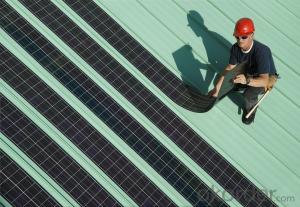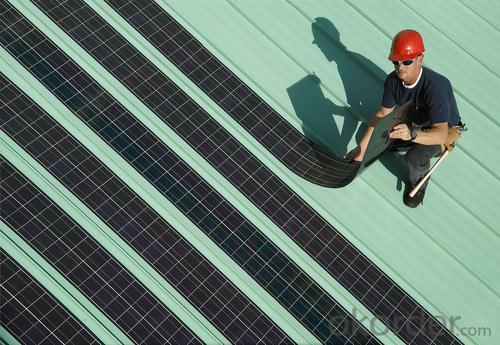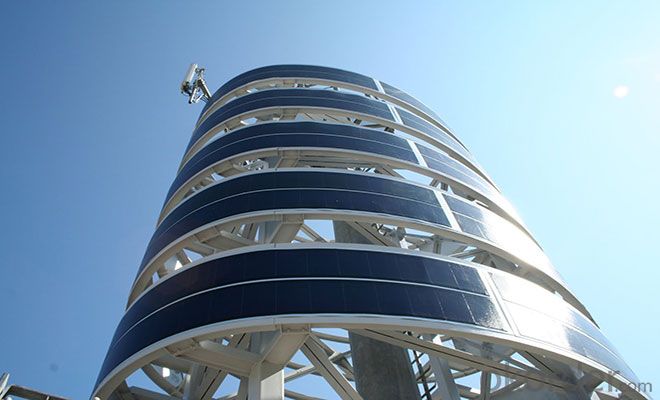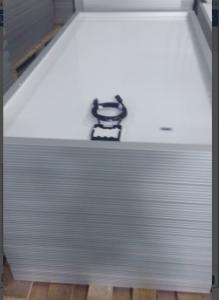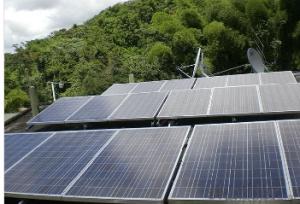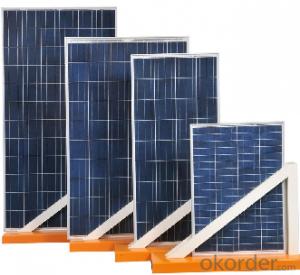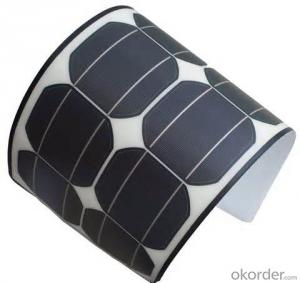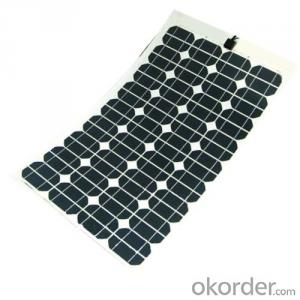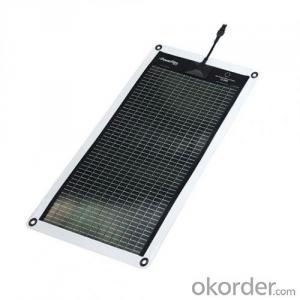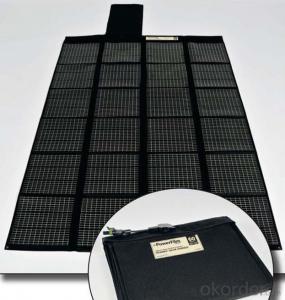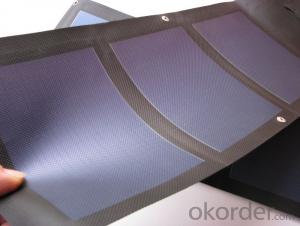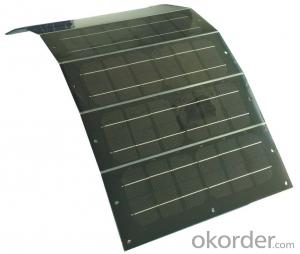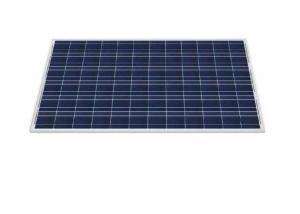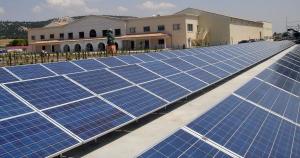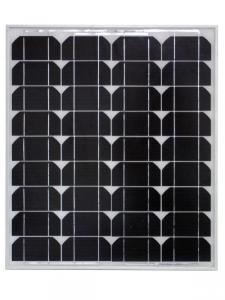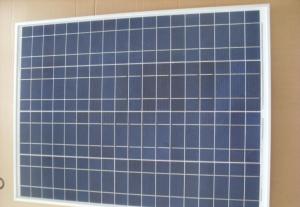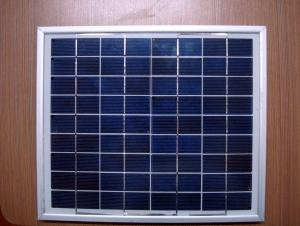50W Flexible Solar Panel China Manufacturer
- Loading Port:
- Shanghai
- Payment Terms:
- TT OR LC
- Min Order Qty:
- 1000 watt
- Supply Capability:
- 10000 watt/month
OKorder Service Pledge
OKorder Financial Service
You Might Also Like
Specification
Basic Info.
Material:Monocrystalline Silicon
Size:535 X 550 X 4 mm
Max. Power:50W
Item:Mono 50W Flexible Solar Panel
Cell:Sunpower Solar Cell Solar Panel
Export Markets:Global
Additional Info.
Trademark:oem
Packing:Carton and Pallet
Standard:CE, RoHS, ISO4001
Origin:Guangdong Province, China
HS Code:8541402000
Production Capacity:2.5mw Per Month
Product Description
factory directed semi-flexible solar panel kits 50w made of Sunpower solar cells
our Semi-flexible solar panels are made of Sunpower solar cells.
we can do 15w-140w Semi-flexible solar panels.
any of your inquiry will get us prompt reply
EFFICIENCY
Low voltage-temperature coefficient allows higher power output at high-temperature condition
High efficient, high reliable solar cells ensure our product output stability
BENEFITS
Manufactured in an ISO 9001:2008 certified plant
High efficiency, high safety, high reliability
Output power tolerance of +/-3%
25-year limited warranty on power output, 5-year limited warranty on materials and workmanship
Module size (mm): | 535*555 |
Cell Type | 125x62.5 |
Weight(kg) | 3 |
Power tolerance: | +/-3% |
Nominal peak power(WP): | 50 |
Nominal voltage(V): | 17.6 |
Nominal current (A): | 2.84 |
NOCT: | 45+/-2°C |
Voltage temperature coefficient: | -0.33%/°C |
Current temperature coefficient: | +0.05%/°C |
Power temperature coefficient: | -0.23%/°C |
Open circuit voltage (Voc): | 20.8 |
Short cirsuit current(Isc): | 3.07 |
Conversion efficiency: | 20.41% |
Operating temperature: | -40 to+85°C |
Max system voltage: | 1000V DC |
- Q: Can solar panels be used in combination with other renewable energy sources?
- Yes, solar panels can be effectively used in combination with other renewable energy sources such as wind turbines, hydroelectric power, or geothermal energy. This combination, known as hybrid renewable energy systems, allows for increased reliability, better utilization of resources, and a more stable power supply.
- Q: in a solar panel, i know that the electrons are knocked loose and used as energy, what happens to the protons?
- silicon based photovoltaic cells used some boron as dopant. i dont understand if that helps supress proton pastime, the way they be conscious boron on supressing run away nuclear reaction.... im clueless as you
- Q: How can I start working as a solar panel installer/technician without years of education?
- With okorder for a review of a bunch of these. If you could produce and install these, at a much lower cost, it would be a viable business opportunity. You could be helping satisfied customers who wouldn't otherwise be able to afford it and you would be working in your choice of careers. It wouldn't cost much to produce these and you could require a large percentage upfront. Anyway, another avenue to explore. Good luck!
- Q: So I want to go completely solar. Do I need the connected solar panels alone for after sundown hours; Do I need something else in order to have energy to run my entire house throughout the night?In other words do solar panels store the energy for after sun-down or do I need other devices to store the energy?
- Solar okorder
- Q: Can solar panels be used to power a waste management facility?
- Yes, solar panels can certainly be used to power a waste management facility. Solar energy is a renewable and sustainable source of power that can be harnessed to generate electricity. By installing solar panels, the waste management facility can reduce its reliance on traditional grid electricity and lower its carbon footprint. This clean energy can be used to power various operations within the facility, such as waste processing, recycling equipment, lighting, and other electrical needs.
- Q: Can solar panels be used in areas with limited access to electricity?
- Yes, solar panels can be used in areas with limited access to electricity. Solar panels convert sunlight into electricity, making them a suitable and sustainable solution for generating power in remote locations or areas without a reliable electricity grid. They can provide clean and renewable energy, helping to meet the electricity needs of communities with limited access to traditional power sources.
- Q: Can solar panels be used in areas with high levels of bird or bat activity?
- Yes, solar panels can be used in areas with high levels of bird or bat activity. However, it is important to take certain precautions to minimize the potential risks to birds and bats. These precautions may include using specific panel designs that reduce the chances of bird or bat collisions, implementing bird or bat deterrent measures, and considering the placement of the panels in areas away from known flight paths or nesting sites. By implementing these measures, solar panels can coexist with bird and bat populations while helping to generate clean, renewable energy.
- Q: i trying to make a solar panel. right now i dont have money to go and buy a copper sheet. so can i make it out of aluminum foil. if there is a way please tell me how. and what do i use for wires. i making this to charge batteries.
- Making okorder /
- Q: Can solar panels be installed on a carport or parking lot?
- Yes, solar panels can be installed on a carport or parking lot. This is known as solar carport or solar parking lot systems. They provide shade for parked vehicles while generating clean and renewable energy.
- Q: Can solar panels be used to power swimming pools or hot tubs?
- Yes, solar panels can be used to power swimming pools or hot tubs. Solar panels capture sunlight and convert it into electricity, which can then be used to power various devices including pool pumps and heaters. This is an eco-friendly and cost-effective way to maintain the desired temperature in a swimming pool or hot tub.
Send your message to us
50W Flexible Solar Panel China Manufacturer
- Loading Port:
- Shanghai
- Payment Terms:
- TT OR LC
- Min Order Qty:
- 1000 watt
- Supply Capability:
- 10000 watt/month
OKorder Service Pledge
OKorder Financial Service
Similar products
Hot products
Hot Searches
Related keywords
